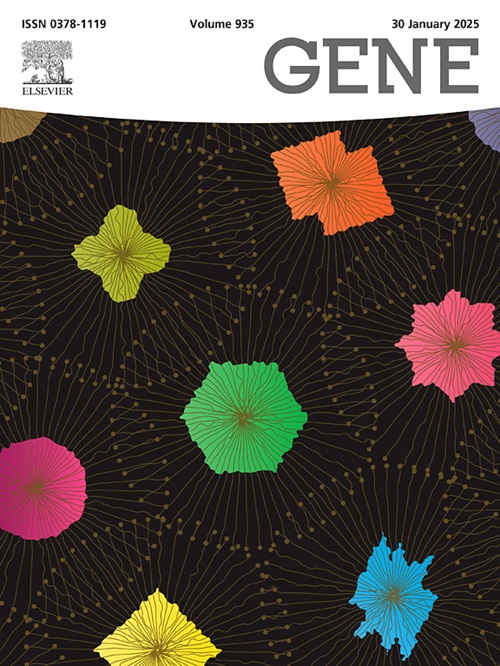基于RNA-seq筛选健康和闭锁猪卵泡颗粒细胞凋亡关键调控因子
IF 2.6
3区 生物学
Q2 GENETICS & HEREDITY
引用次数: 0
摘要
异常卵泡闭锁的分子机制仍有待阐明。迄今为止的研究表明,卵巢颗粒细胞(GC)凋亡是卵泡闭锁的重要因素。卵泡闭锁异常可导致猪繁殖效率下降。显然,针对健康卵泡、早期闭锁和进行性闭锁的比较研究,特别是从卵巢GC细胞凋亡诱导卵泡闭锁的角度进行的比较研究尚未见报道。具体而言,使用RNA-seq技术系统分析闭锁不同阶段GCs中差异表达的基因和相关信号通路仍未探索。研究分为三个不同的组:对照组、早期闭锁组和逐渐闭锁组。通过RNA-seq对关键基因和信号通路进行了分析。维恩图显示86个重叠基因在早期闭锁期间上调,在进行性闭锁期间下调。此外,另外47个重叠基因在早期闭锁期间下调,在进行性闭锁期间上调。这133个重叠基因在多个KEGG通路中显著富集。此外,结合关键基因相关网络图,进一步筛选出6条与卵巢GC凋亡相关的信号通路。这些途径包括卵巢甾体发生、孕激素介导的卵母细胞成熟、促性腺激素释放激素信号通路、rig - i样受体信号通路、nod样受体信号通路和趋化因子信号通路。总共鉴定出12个关键基因:SCARB1、IGF1、PRKACA、ADCY6、LDLR、PLD1、CXCL10、IRF7、ISG15、RNase L、OAS2和STAT1。随机选取其中6个基因进行qRT-PCR验证,发现其表达水平与测序结果一致。因此,确定参与细胞凋亡过程的关键调控因子为研究猪卵泡异常闭锁的机制提供了理论基础。本文章由计算机程序翻译,如有差异,请以英文原文为准。
Screening of key regulatory factors in apoptosis of granulosa cells in healthy and atretic pig follicles based on RNA-seq
The molecular mechanism underlying abnormal follicular atresia remains to be elucidated. Research conducted to date has indicated that ovarian granulosa cell (GC) apoptosis is a significant contributor to follicular atresia. Abnormalities in follicular atresia can result in decreased reproductive efficiency in pigs. It is evident that comparative studies focusing on healthy, early atresia and progressively atresia follicles, particularly from the perspective of follicular atresia induced by ovarian GC apoptosis, have not yet been reported. Specifically, the use of RNA-seq technology to systematically analyse differentially expressed genes and associated signaling pathways in GCs at different stages of atresia remains unexplored. The research was divided into three distinct groups: control, early atresia, and progressively atresia. Key genes and signaling pathways were elucidated through RNA-seq. A Venn diagram revealed 86 overlapping genes that were upregulated during early atresia and downregulated during progressively atresia. Additionally, another 47 overlapping genes were found to be downregulated during early atresia and upregulated during progressively atresia. These 133 overlapping genes were significantly enriched in multiple KEGG pathways. Additionally, in conjunction with the key gene-related network diagram, 6 signaling pathways related to ovarian GC apoptosis were further screened out. These pathways include ovarian steroidogenesis, progesterone-mediated oocyte maturation, gonadotropin-releasing hormone signaling pathway, RIG-I-like receptor signaling pathway, NOD-like receptor signaling pathway, and chemokine signaling pathway. Altogether, 12 key genes were identified: SCARB1, IGF1, PRKACA, ADCY6, LDLR, PLD1, CXCL10, IRF7, ISG15, RNase L, OAS2, and STAT1. Six of these genes were randomly selected for qRT-PCR verification, and their expression levels were found to be consistent with the sequencing results. Consequently, the identification of key regulatory factors involved in the apoptotic process provides a theoretical foundation for investigating the mechanisms underlying abnormal follicular atresia in pigs.
求助全文
通过发布文献求助,成功后即可免费获取论文全文。
去求助
来源期刊

Gene
生物-遗传学
CiteScore
6.10
自引率
2.90%
发文量
718
审稿时长
42 days
期刊介绍:
Gene publishes papers that focus on the regulation, expression, function and evolution of genes in all biological contexts, including all prokaryotic and eukaryotic organisms, as well as viruses.
 求助内容:
求助内容: 应助结果提醒方式:
应助结果提醒方式:


